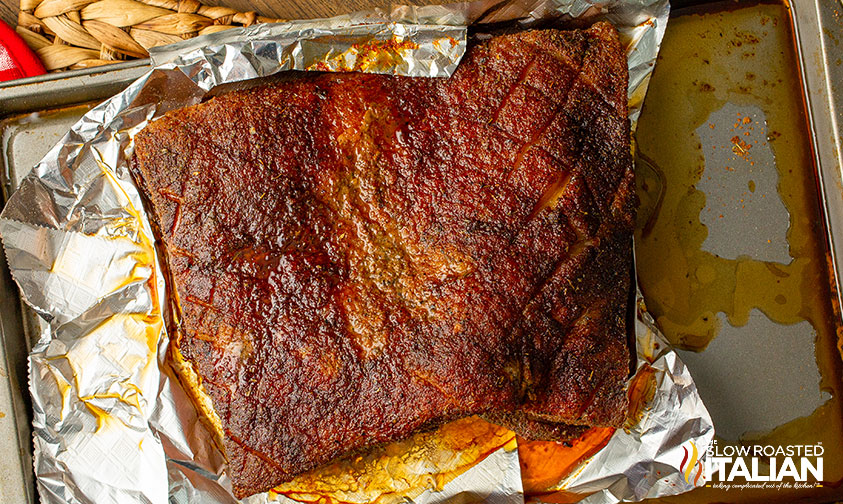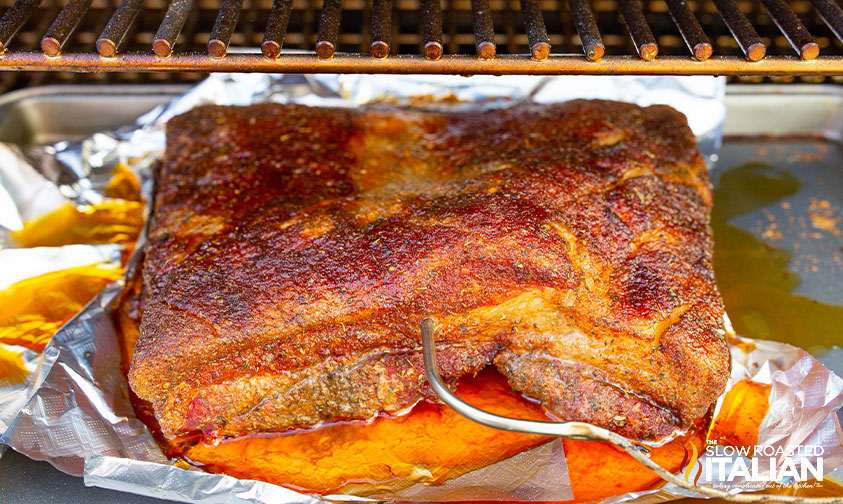Smoked Pork Belly recipes are a dime a dozen, but this one is a cut above the rest. The pork belly on the smoker tastes amazing! It’s covered in a sweet and spicy dry rub, basted in apple juice the whole time, and slowly smoked to just the right temperature. This recipe has the best smoky flavor there is!
Smoked pork belly has a sweet, sticky crust that can only be made by smoking it for hours. The meat is juicy and has a rich, fatty flavor.
Don’t let the summer pass you by without trying a new recipe for your grill or smoker. Now is the perfect time to learn how to smoke pork belly!.
Don’t get me wrong, smoking pork belly is certainly an involved process. But I promise, it’s worth it! Once you take that first bite, you’ll be totally hooked.
This is the cut of meat that’s left over after the spareribs are cut away. It’s the fatty, richest cut of meat you can find.
As far as smoked pork belly recipes go, there are almost countless uses for the meat.
You can put smoked pork belly strips on sandwiches, shred them for tacos or carnitas, put them on top of nachos, or just serve the burnt ends of pork belly.
Pork belly is a deliciously fatty and flavorful cut of meat that when cooked properly becomes melt-in-your-mouth tender with crispy, crackling skin. However, cooking pork belly can be tricky. Undercook it and the fat won’t render out correctly, leaving you with a chewy and overly fatty result. Overcook pork belly and it will dry out. That’s why knowing the right internal temperature is key for pork belly perfection.
In this complete guide, we’ll cover everything you need to know to cook pork belly to the ideal doneness, including:
- Why temperature matters when cooking pork belly
- Recommended internal temperatures for different styles of pork belly
- How to accurately measure the temperature of pork belly
- Tips to prevent under or overcooking
- How long to cook pork belly based on thickness and method
- Visual and textural cues that pork belly is done
- Serving suggestions once pork belly reaches the ideal internal temperature
Follow these tips and you’ll be able to achieve tender, mouthwatering pork belly every time Let’s get cooking!
Why Temperature Matters When Cooking Pork Belly
Pork belly is a tough cut of meat made up of a large amount of fat and connective tissue. To break these down and render the fat properly requires bringing the pork belly to the right internal temperature. If the temperature is too low, the fat won’t liquefy correctly and you’ll end up with a rubbery, greasy mess. The temperature needs to be high enough to melt the fat and collagen while still keeping the meat juicy.
Additionally, pork requires a minimum safe cooking temperature to destroy any potential foodborne pathogens like salmonella. While whole cuts of pork now only require 145°F, pork belly should be cooked to at least 160°F since it contains more fat and connective tissue that needs to fully break down.
Recommended Internal Temperatures for Pork Belly
The optimum internal temperature for pork belly depends on whether you want the meat fully tender and shredable or slightly firmer with a mix of textures. Here are the recommended temperatures:
-
145-150°F – The meat will be slightly pink with a firmer, steak-like texture. Good for pan-fried or roasted pork belly.
-
160°F – The collagen starts to melt, making the meat very tender but still able to be sliced. Ideal for Chinese-style roast pork belly.
-
185-203°F – The pork belly is fall-apart and shredable. Great for braises, stews, grilling, and smoking.
The renders fat should reach at least 185°F to become liquid. For pulled or shredded pork belly, aim for 195-203°F.
How to Accurately Measure the Internal Temperature
A good instant read meat thermometer is indispensable for cooking pork belly to the right doneness. Here are some tips for the most accurate temperature readings:
-
Insert the thermometer into the thickest part of the meat, away from any bones.
-
Push the probe in at least 1-1.5 inches deep into the pork belly.
-
Take temperatures in a couple different spots to account for uneven cooking.
-
Double check the temperature towards the end of the estimated cook time.
-
For very large cuts of pork belly, check in multiple areas.
-
Make sure to clean the thermometer probe thoroughly before each use for hygiene.
Tips to Prevent Under or Overcooking
In addition to monitoring with a meat thermometer, here are some tips to prevent under or overcooking pork belly:
-
Bring pork belly to room temperature before cooking for more even heating.
-
Pre-score the skin before cooking for better rendering and crisping.
-
Cook pork belly low and slow at 300-325°F if braising or smoking.
-
Turn the pork belly over halfway during roasting or grilling.
-
Reserve and reuse pork belly fat drippings for extra flavor.
-
Let pork belly rest for 10-15 minutes before slicing into it.
Cook Times for Different Thicknesses and Methods
The thickness of the pork belly will affect the cooking time needed. Here are estimated cook times based on cut thickness and cooking method:
For 1-inch thick pork belly:
-
Roast at 400°F for 45 minutes to 1 hour
-
Grill or pan fry for 12-20 minutes per side
-
Braise or smoke at 300°F for 1 1/2 – 2 hours
For 2-inch thick pork belly:
-
Roast at 350°F for 1 1/2 – 2 hours
-
Grill for 20-30 minutes per side
-
Braise or smoke at 300°F for 3-4 hours
For 3-inch thick and larger cuts:
-
Roast at 325°F for 2 1/2 – 3 1/2 hours
-
Grill for 30-45 minutes per side
-
Braise or smoke for 5+ hours at 300°F until fork tender
Always rely on an instant read thermometer for the most accurate doneness rather than cook times alone. Cook times can vary based on the particular oven or grill being used.
Visual and Textural Cues Pork Belly is Done
In addition to checking temperature, look for these signs that the pork belly is cooked properly:
-
The meat has turned from pink to white.
-
The fat has rendered and browned.
-
The skin is browned, crispy, and crackly (if left on).
-
A fork or knife inserted into the meat meets little resistance.
-
The pork belly shreds easily when poked and prodded.
Serving Suggestions Once Pork Belly Reaches Ideal Temperature
Pork belly is incredibly versatile once cooked to the ideal doneness. Here are just a few serving ideas:
-
Slice into thick strips and eat with steamed rice or roasted veggies.
-
Chop or shred the pork belly for tacos, sandwiches, omelets and stir-fries.
-
Cube the pork belly for adding to soups, stews, beans or pasta dishes.
-
Slice thinly and add to salads, pizza or charcuterie boards.
-
Pair with lighter flavors like citrus, herbs, vinegar, and mustard to cut the richness.
-
Use smaller pieces for appetizers like pork belly skewers and dumplings.
No matter how you serve it up, pork belly cooked to just the right internal temperature is savory, succulent and full of flavor. Now that you know the ideal temps and techniques, you can achieve pork belly perfection right in your own kitchen.

How Long to Smoke Pork Belly
The timing needed for pork belly smoker recipes will depend, of course, on the weight of the cut.
To reach 160°F inside the pork belly during the first round of smoking, the cut should be as thick as possible.
In general, though, the first smoking will take about 4 hours, and the smoking in the apple juice will take an extra hour. This is with the smoker preheated to 225°F.

Pork Belly Smoker Tips
- Don’t cut off the fat—I mean it! The fat will keep the surface of the pork belly from getting too hot or dry while it’s smoking. Trimming the fat can directly translate to tough, dry meat. For the best results, just score the fat without going through the meat.
- Use the right type of wood. Your smoked pork belly recipes will taste better if you use the best wood chips. Since the baste is made from fruit, pick a fruity wood. I like apple.
- Buy the right cut of pork. The meat should be reddish-pink, with creamy white fat. You should also pick a cut that has skin taken off. So the rub can really get into the meat, and the smoke can do its thing.

Pork Cooking Temperature & Meat Thermometer Basics
FAQ
What temperature should pork belly be?
How do you know when pork belly is done?
Is pork done at 180?
What is the internal temperature of pork belly burnt ends?
What temperature should pork belly be cooked to?
However, it’s important to cook pork belly to the right temperature to ensure that it is cooked through but not overcooked. The ideal internal temperature for pork belly is between 160-165°F (71-74°C). At this temperature, the pork belly will be cooked through but still juicy and tender.
How long should a pork belly be cooked at 375?
When roasting pork belly, it’s generally recommended to cook it for 1.5 to 2 hours at 375°F to 400°F, or until the internal temperature reaches 160°F. For grilling, pork belly should be cooked for about 30 minutes per side at medium-high heat.
How long do you cook a 2 pound pork belly?
For oven roasting, a 2-pound pork belly should be cooked for about 2-2.5 hours at a temperature of 275°F. The initial high temperature of 450°F for the first 30 minutes helps to crisp up the skin, but it’s important to lower the temperature to prevent overcooking.
How do you cook pork belly slowly?
To cook pork belly slowly, as in Chef John’s Caramel Pork Belly recipe, you should: ‘want to slowly cook the pork belly so it gets very tender and the fat has time to render to baste the meat as it cooks’, Herrera says. ‘This is a tough muscle so it needs a longer cooking time at low heat to breakdown the tough tissue.’ To slow roast pork belly: ‘low and slow for the win’.
